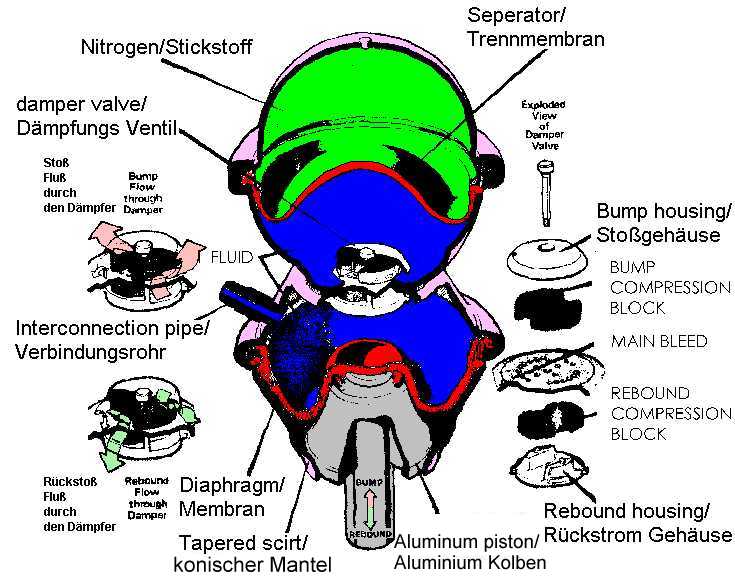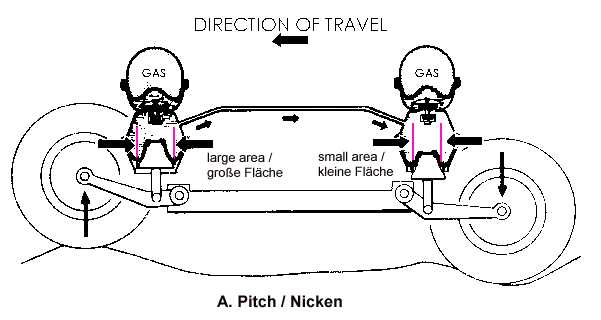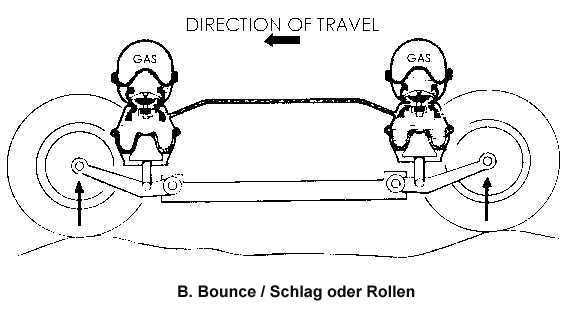MGF Hydragas Suspension
English language Original Source http://ferrari.me.queensu.ca/dynamics/topics/hydragas.html
(closed down unfortunaltely
German language edited Source
Experimental characterization and mathematical modeling of the Moulton
Hydragas automobile suspension Author: Geoff Rideout 1998
Summary of Research
The Hydragas suspension system (see below) from a Rover Group MGF sports car was statically tested to determine the static spring properties. A stiffness matrix was generated that included terms due to individual unit and interconnection effects. Dynamic tests were performed at various sinusoidal amplitudes and frequencies to calculate the damping matrices. One unit was held at its datum position while the other was moved. The damping force vs. velocity diagrams indicated the presence of inertial effects and dynamic stiffness due to rubber hysteresis.
Three models were developed to predict forces transmitted through the units. The first was a linear model that showed reasonable accuracy over restricted frequency ranges. The second model used bilinear spring and damping constants, and was accurate for predicting force at both the front and rear units for frequencies from 1 to 10 Hz. The third model treated the inertial and compressibility effects by inserting a mass into the spring-damper system. The magnitude of the mass was estimated based on the areas of the damper force vs. velocity diagrams. The inertial model did not predict peak forces as well as the bilinear spring/bilinear damper model, but was better able to predict phase lags between the forces at the dynamically excited unit and at the stationary unit.
The Hydragas System
Designers have considered for decades the interconnection of the front and rear wheels as a means by which to reduce unpleasant pitch behaviour of small cars. In an interconnected, or "equalising" suspension, the front and rear wheels on each of the driver and passenger sides are interconnected, forming two independent systems wherein an input at one wheel will cause a force to be generated at the other.
A forward-travelling car will first encounter disturbances at the front wheels that tend to lift the front of the car in relation to the rear. Interconnection has striven to transmit some the upward vertical motion of the front wheel into a downward force exerted by the sprung mass on the rear wheel, through the rear suspension. Reducing the differential between front and rear forces on the car body induces more of a bounce mode of vibration than a pitching mode.
Pitching motion, which causes fore-and-aft movement of the occupants, is generally regarded as being more objectionable than bounce motion [1]. Smaller cars are particularly susceptible to being set into a pitching mode compared to large cars, and it is this "choppy" quality to which many people attribute the inferior ride of small cars.
The Hydragas suspension was developed by Dr. Alexander Moulton of Great Britain to improve the ride quality of small cars. The system uses nitrogen gas as the springing medium and hydraulic fluid pressure drop as the damping mechanism. The damping fluid chambers of the front and rear wheels on each side of the car are connected via a hydraulic hose, such that an input at the front wheel pumps fluid through the pipe to the rear wheel. The increase in fluid pressure at the rear unit creates an upward force on the sprung mass, thus reducing the differential between suspension forces on the front and rear of the car body.
Figure 1 [2] depicts a later-generation Hydragas unit. Each unit contains both a gas spring and a damper spring

Figure 1 - Hydragas Suspension Unit Cutaway [2]
A butyl rubber separator, in concert with metal sealing rings and overlapping case pressings, seals the nitrogen gas from the fluid. The lower diaphragm is composed of a sealing rubber layer atop a structural rubber layer. Upward vertical movement of the tapered aluminium piston increases the area of the diaphragm against which fluid pressure acts, and vice versa. Sufficient pressure differential between the upper and lower chambers compresses either the bump or rebound compression block, increasing fluid flow as a function of pressure difference. The Hydragas units used in the present research project were from the new Rover MGF sports car, and featured a smaller-volume gas chamber and a damper valve of different construction. The function of the compression blocks was performed by normally-closed metal leaf-spring flaps.
Figure 2a [2] shows the general response of an interconnected Hydragas system to pitch-inducing motions in which the front wheel is lifted in relation to the car body, while the rear wheel is lowered. The upward motion of the front wheel in pitch displaces fluid to the rear unit, causing the rear wheel to exert an upward force on the car body. Simultaneous upward front wheel and downward rear wheel motion not only positively displaces but also draws fluid from the front to the rear unit. The stiffness, or resistance of the system to such wheel motions, is clearly lower than it would be were the interconnection removed.
The variable-area pistons stabilize the pitch oscillations. After the wheel motion of Figure 2a occurs and pressure stabilizes in the system, the larger area of the front piston causes a higher downward force on the front wheel than does the fluid pressure acting on the smaller piston area of the rear unit. The piston area variation thus produces a restoring moment about the pitch axis.
Figure 2b [2] depicts response in pure bounce or roll
in which both wheels on one side of the car move the same distance in
relation to the body. No flow occurs from one unit to the other, with
flow occurring only between the upper and lower chambers of individual
units through the damper valves. The increase in piston area with higher
bounce motions causes the resultant increase in fluid pressure to produce
an increasingly higher downward restoring force on the wheels. The system
thus has a progressive rate characteristic. The combination of higher
fluid pressures and increasing piston areas give the system a higher stiffness
in bounce and roll than in pitch,
possibly obviating the need to fit a front anti-roll bar [2].


Figure 2 - Hydragas Suspension System Excitation Modes [2]
References
1. Gillespie, T.D. (1992) Fundamentals of Vehicle Dynamics.
Warrendale, PA: Society of Automotive Engineers.
2. Moulton, A.E., and Best, A. (1979) "Hydragas Suspension." SAE Paper
SAE-790374.
Other Interconnected Suspension References
1. Moulton, A.E. (1962) "Hydrolastic Springing." Automobile Engineer,
Sept. 1962, pp.328-336.
2. Moulton, A.E., and Best, A. (1979) "From Hydrolastic to Hydragas Suspension."
Proc. Council of the I Mech. E v.193, no.9, pp.15-25.
3. Moulton, A.E., and Turner, P.W. (1956) "Rubber Springs for Vehicle
Suspension." Proc. Auto. Div. Inst'n Mech. Engrs 1956-7, no.1, pp.17-41.
4. Pevsner, J.M. (1957) "Equalizing Types of Suspension." Automobile Engineer,
Jan. 1957, pp.10-16.
Rideout, D.G., and
Anderson , R.J. (2003) "Experimental Testing and Mathematical Modeling
of the Interconnected Hydragas Suspension System." SAE Journal of
Passenger Cars – Mechanical Systems
download
#More stuff from Geoff (2000 on)
File #1 / File
#2 / File #3
/ File #4


